|
Samarkand was founded in the 5th century BC and
is probably the oldest town in Central Asia. In Arabic, it was called
Marakanda. It prospered, being on the major trade route to China,
the Silk Route. For a long time, it was the economic, cultural and
intellectual center of
Uzbekistan, but in the 16th century, the
capital was moved to
Bukhara, and many people left the city
after a series of earthquakes.
The Russians made the city again more popular by their trans Caspian
railway, and again the city was made capital o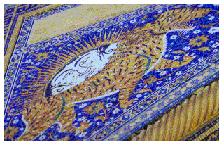 f Uzbekistan, but again it was
only temporarily,
from 1924 till 1930. After that the honor was given to
Tashkent. But long
before that Samarkand was famous being capital on and off and often being
the favorite city of well known rulers. In 1220, Samarkand was one of the
cities on the devastating trail of f Uzbekistan, but again it was
only temporarily,
from 1924 till 1930. After that the honor was given to
Tashkent. But long
before that Samarkand was famous being capital on and off and often being
the favorite city of well known rulers. In 1220, Samarkand was one of the
cities on the devastating trail of
 Genghis Khan, the first worldwide
tourist to enter history books. He left the city totally plundered. In 1370 the great Timur decided to make
Samarkand capital of his empire, and called it, with the megalomania that is
usual to rulers of his kind, "Centre of the Universe", a universe that
reached from India to
Turkey. Genghis Khan, the first worldwide
tourist to enter history books. He left the city totally plundered. In 1370 the great Timur decided to make
Samarkand capital of his empire, and called it, with the megalomania that is
usual to rulers of his kind, "Centre of the Universe", a universe that
reached from India to
Turkey.
Timur's favorite grandson Ulughbek also reigned Samarkand
during 40 years and, being more of a scholar, made it into an intellectual
centre as well. Nowadays the Ulughbek observatory here still remembers us
of him. The three storey observatory was built in 1420. After his death it
was destroyed but the track was discovered again in 1908. The star charts he created were used by
many in his time.
|
|
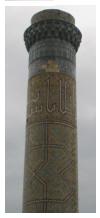  The Registan, (the word
means "Sandy place") pictured on top of the page, must be the most
famous and impressive site of Uzbekistan. In the early days, it must have
been the center of business and trade and justice was carried out there. It has beautiful colors, gold,
emerald and mostly deep blue in many glazed tiles. The Registan, (the word
means "Sandy place") pictured on top of the page, must be the most
famous and impressive site of Uzbekistan. In the early days, it must have
been the center of business and trade and justice was carried out there. It has beautiful colors, gold,
emerald and mostly deep blue in many glazed tiles.
It was still a sandy place in Timur's time, as only Ulughbek finished building. Now, it consists of three madrassahs
(Islamic colleges): the Ulughbek madrassah on the west (1417), the Sher Dor
(building with lions) madrassah to the east (1619) and finally the Tillya
Kari (gold covered) madrassah, which was completed in 1660, in the
middle. Ulughbek had the madrassah built that was named after him, and is said to have taught there
himself. The other two
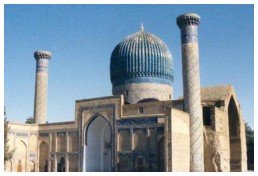 madrassahs were built by Shaybanid Emir Yalangtush. The Shir
Dor, as can be seen on the left, has an animal on the front that looks
like a tiger but is actually a lion. Lion or tiger, they were both forbidden
to be depicted by Islam and therefore it is a miracle that they are still
there after all those centuries of Islam reign. madrassahs were built by Shaybanid Emir Yalangtush. The Shir
Dor, as can be seen on the left, has an animal on the front that looks
like a tiger but is actually a lion. Lion or tiger, they were both forbidden
to be depicted by Islam and therefore it is a miracle that they are still
there after all those centuries of Islam reign.
Timur was laid to rest in the Gur-i Amir, the "tomb of the ruler".
The large tiled domes can be seen from almost all parts of the city and give
you a sense of direction. It is an
octagonal mausoleum and was completed in 1404. Also other members of his
family, like his grandson Ulughbek, are lying here. On the tomb lies a piece
of jade, brought from Mongolia by Ulughbek in 1425, and broken by Nadir Shah
from Persia in his effort to steal it. In the jade it can be read that:
"When I rise, the world will tremble." Unfortunately, the world already
trembled without Timur coming to life, which partly destroyed another of his
accomplishments, the Bibi Khanum Mosque. |
|
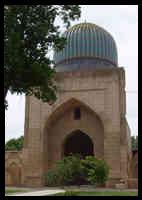  The Bibi
Khanum Mosque is one of Timur's biggest projects, dedicated to his
Chinese
and chief wife Bibi (Saray Mulk) Khanum. Many
legends are The Bibi
Khanum Mosque is one of Timur's biggest projects, dedicated to his
Chinese
and chief wife Bibi (Saray Mulk) Khanum. Many
legends are
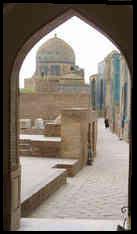 told about this mosque, but they all center around the
(extra-marital) relationship between Timur's wife and the architect
who built the place, so she may have been his chief wife, but he was not
her chief husband. The architect was beheaded after the mosque was
finished. Maybe as a belated punishment to the unfaithful wife, the mosque
was severely damaged in the earthquake of 1897. Actually it was so big,
that it already started to fall to pieces soon after it was
built. told about this mosque, but they all center around the
(extra-marital) relationship between Timur's wife and the architect
who built the place, so she may have been his chief wife, but he was not
her chief husband. The architect was beheaded after the mosque was
finished. Maybe as a belated punishment to the unfaithful wife, the mosque
was severely damaged in the earthquake of 1897. Actually it was so big,
that it already started to fall to pieces soon after it was
built.
Shah-i-zinda (meaning "The living king") is a lane full of
monuments, mostly for Timur and his descendents. Nowadays it is still a
place of pilgrimage, with many pilgrims mingled among the tourists. They
visit the only grave that does not belong to Timur's family, namely
Khusam-ibn-Abbas's, who is said to be a cousin of the Prophet Mohammed.
The legend goes that he took his own head from his shoulder and hid it
somewhere in here, thus giving it the name of "The Living
King".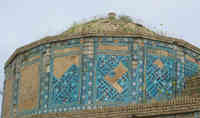 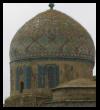 |